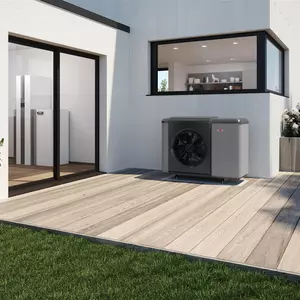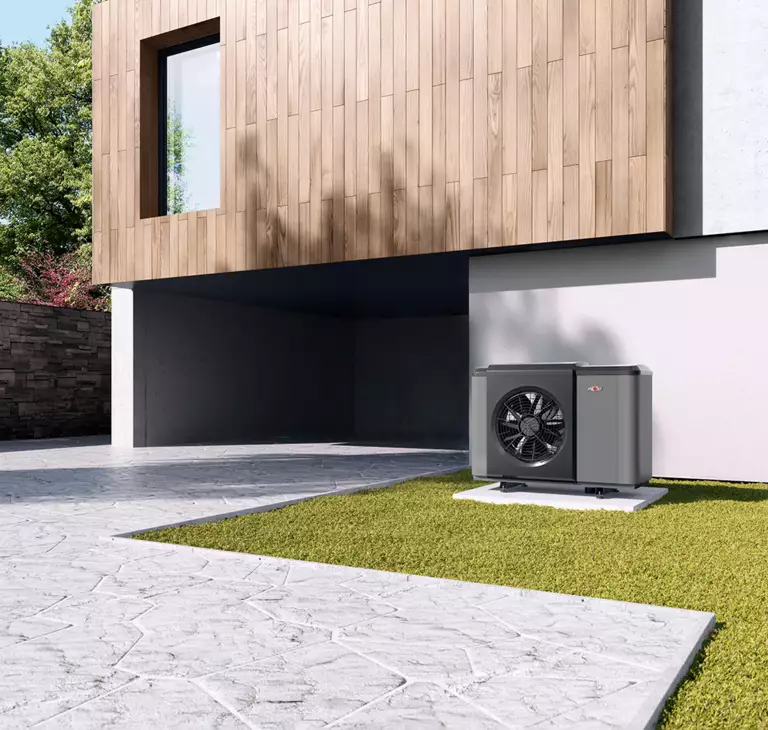
Outdoor installation and indoor installation of heat pumps
Overview of benefits and drawbacks
Choosing the ideal heat pump is not only a matter of your preferred energy source, it is also affected by the options available at the installation site. While brine-to-water and water-to-water heat pumps must always be installed outdoors for technical reasons, air-to-water heat pumps can also be operated indoors. This article presents the benefits and drawbacks of installing heat pumps indoors.
How do heat pumps work?
Heat pumps are very efficient heating systems that are particularly environmentally and climate friendly. Heat pumps are a source of renewable energy. They can use the ambient air, groundwater or geothermal heat as an energy source. Heat pumps are extremely popular amongst consumers. For instance, in 2020, around 45.8% of all new building owners in Germany decided to install a heat pump. In 2021, a little more than half (50.6%) of all house builders already favoured the heat pump over other heating systems.
The reverse refrigerator
Heat pumps work on the same principle as the fridge in your kitchen. They draw thermal energy from one side of the system and discharge it on the other side. Your fridge is only kept cold on the inside and dissipates the thermal energy into the kitchen. This is why the back panels of fridges heat up. If we reverse this principle, we can route the thermal energy from the surrounding area into an interior space. In the case of a heat pump, the thermal energy from the preferred source (air, water or geothermal) is routed directly into a building’s heating system. As in a fridge, a refrigerant circulates in the heat pump. It absorbs the heat from the energy source, which causes it to vaporise.
A compressor further raises the temperature of the refrigerant so that it can transfer sufficient thermal energy to the heating circuit. There, a heat exchanger transfers the energy to the heating system. This causes the refrigerant to expand and cool again. Then the cycle begins again. So running a heat pump requires electricity, but the heat pump supplies considerably more thermal energy than it consumes in electrical energy. The principle is particularly environmentally friendly if the heat pump is run using electricity from a photovoltaic system.

Major benefits of heat pumps:
Heat pumps are superior to conventional fossil-fuel-based heating technologies in terms of efficiency, operating cost and climate friendliness.
No emissions from fossil fuels
CO2-neutral operation possible if solar power is used
Use of free environmental heat reduces the cost of heating
No need to stockpile fuels
Minimal maintenance
Reduces dependence on commodity markets
Overview of the various types of heat pump
The different types of heat pumps are classified by the energy source they use. They differ in their levels of efficiency, purchase prices, operating costs and expenses for installation and maintenance. The three main types of heat pumps used in private households are:
- Air-to-water heat pumps use the ambient air around the building as a heat source and transfer it to the heating circuit. They are also knows as air source heat pumps.
- Water-to-water heat pumps use the groundwater as a heat source.
- Brine-to-water heat pumps use the stable temperatures of the ground at greater depths and are also known as geothermal heat pumps.
Benefits and drawbacks of the various heat pump types
Air-to-water heat pumps
Air-to-water heat pumps are inexpensive and cheap and easy to install. The set-up options are also very flexible. Their disadvantages include slightly higher electricity consumption and lower efficiency compared to other types of heat pumps. Their efficiency can drop in winter as they depend on the outside air to supply them with thermal energy. However, this slight drop in efficiency can easily be compensated for by taking appropriate measures, such as installing a heating rod or cleaning the fans regularly.
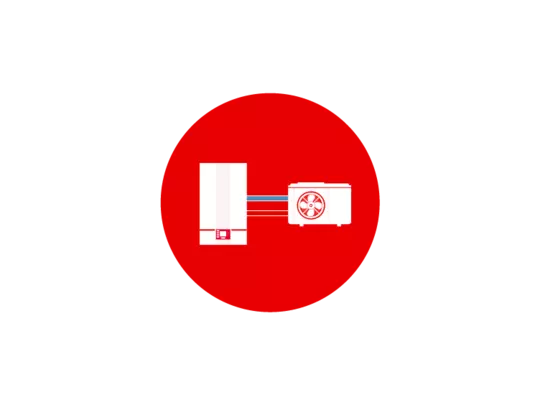
Water-to-water heat pumps
Water-to-water heat pumps are very efficient because they use thermal energy from the groundwater to heat a building. As the groundwater temperature stays largely constant all year long, weather conditions and seasons do not greatly affect the performance of these heat pumps. The disadvantages are caused by the major technical complexity of using this heat source. Furthermore, permits are required to do so and are not always issued to homeowners, depending on where they live.
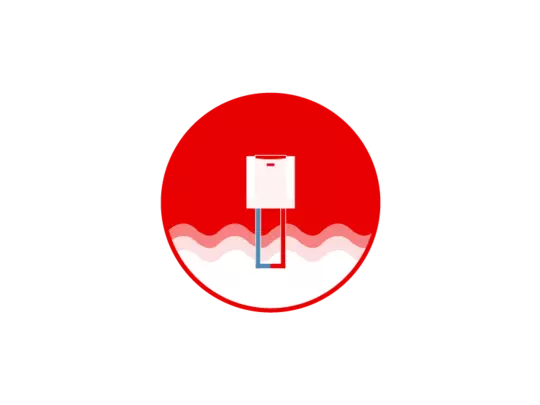
Brine-to-water heat pump
Brine-to-water heat pumps, often also called geothermal heat pumps, exploit the fact that the ground has a constant temperature of 10°C from a certain depth. Due to this consistently high temperature, geothermal heat pumps are exceptionally efficient all year round. The disadvantages include complex installation. Users must also obtain permits for particularly deep boreholes for vertical geothermal probes. Alternatively, geothermal collectors can be installed close to the surface, but this takes a comparatively large area of land. It is often difficult to retrofit systems of this kind.

Which heat pumps are suitable for indoor installation?
If you are looking for a heat pump for indoor installation, your choice is limited as both water-to-water and brine-to-water heat pumps are only suitable for outdoor installation. This is related to the construction requirements for laying geothermal collectors, drilling for geothermal probes or using groundwater. Air-to-water heat pumps, on the other hand, are suitable both for indoor installation (e.g. in a cellar) and for outdoor installation on the property. This overview does not include air-to-air heat pumps as these are only relevant for buildings with ventilation systems.

Top advice from WOLF
If you are looking for an efficient heat pump for your existing building or a new build, you should seek in-depth advice. Correct dimensioning and careful planning are crucial for efficient heating. The experts at WOLF will be happy to help you.
Do heat pumps installed indoors and outdoors work in different ways?
The principle of operation is identical. Air source heat pumps installed indoors still use the outdoor ambient air as an energy source. They require suitable air ducts in the façade of the building to allow the air to be taken in and discharged. The energy efficiency and economy of air source heat pumps is not greatly affected by their being installed inside or outside. Projects of this kind are usually easier to implement in new buildings due to the spatial requirements for indoor installation of the heat pump. But heat pumps installed indoors can also often be retrofitted during energetic refurbishment projects in existing buildings. For instance, when replacing old oil-fired heating systems, the space previously taken up by the oil tank can be used to install a heat pump.
Monoblock or split heat pumps?
There are two basic alternatives for indoor heat pump installation. The first variant is monoblock design, which is suitable for both indoor and outdoor installation. If you have sufficient space, you can install a monoblock heat pump in the basement of your house, for example. If you do not have the necessary space inside, monoblock heat pumps work just as efficiently when installed outdoors. These only require connections for taking in and discharging the ambient outside air and a connection to the heating circuit. A condensate drain is also needed for indoor installation of monoblock heat pumps so the installation space must have a waste water connection.
The alternative is the split variant. In split heat pumps, heat is generated by an outdoor unit. The more compact indoor unit is only used to condense and expand the refrigerant. The two components are connected via the refrigerant circuit.
Air-to-water heat pumps
Efficient, stylish, quick to install
The powerful CHA monoblock heat pump is the superstar of our heat pump range. It is suitable for both indoor and outdoor installation, making it outstandingly versatile. It also has a stylish and unobtrusive design conceived by famous luxury yacht designer Espen Øino.

Benefits and drawbacks of indoor installation and outdoor installation of heat pumps
It is not only the matter of space requirements that can make outdoor installation of heat pumps the better choice. Structural work in the house (such as opening holes in walls) can also usually be minimised as the heat pump only has to be connected to the heating water pipes.
On the other hand, the noise made by the heat pump outside can lead to disputes with neighbours. Modern appliances do not usually exceed the permissible limits for noise pollution in residential areas. Nevertheless, outdoor installation may entail challenges due to building regulations regarding required clearances which are not an issue at all when installing a heat pump indoors.
Another advantage of indoor installation is that the heat pump is not exposed to the wind and weather, which extends its service life Split heat pumps must be installed by a qualified heating engineer due to the structural separation of the appliance components. Technicians are only permitted to connect refrigerant circuits if they have a refrigeration certificate.
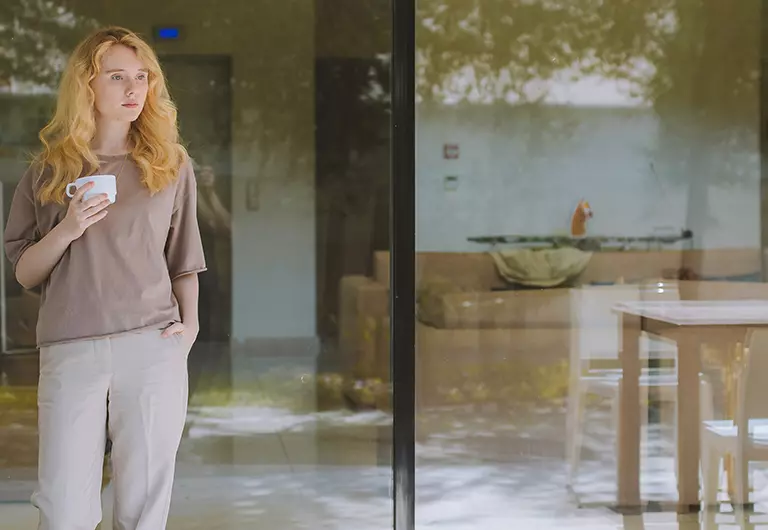
Tips for reducing acoustic levels
The following tips can help you to operate your heat pump as quietly as possible:
Do not place the intake or exhaust openings directly next to bedroom or study windows.
Avoid transmission of structure-borne sound to the building. The more level the installation site, the better.
Use flexible hose connections to decouple vibrations.
Niches and corners can amplify the noise made by outlets.
If possible, install the intake opening on a low-noise side.
Which locations inside the house are suitable for indoor installation of a heat pump?
In addition to the required space, you must also take the often quite heavy weight of the heating system into account when purchasing a heat pump for indoor installation. Depending on which storey the space is on, you must always ensure that the site has the necessary load-bearing capacity. In addition, the installation site should be as level as possible. As a rule, cellars, utility rooms, the ground floor and even the attic are suitable for indoor installation in residential buildings, provided that the load-bearing capacity is sufficient and you can ensure that the heat pump is acoustically decoupled from the building. Air ducts must be routed above ground. This is especially important in basements. For instance, it is less favourable for air ducts to exit into a light well, for example, because cold air collects there.
What is a thermal short-circuit?
Thermal short-circuits are sometimes generated when heat pumps are installed. This phenomenon occurs when the heat pump sucks the cold extract air straight back in because the air outlet and intake openings are too close together This significantly reduces the efficiency of your heat pump. So it is advisable to site the openings as far away from each other as possible.
Is it better to install heat pumps indoors or outdoors?
Modern heat pumps work with approximately the same efficiency either way. Heat pumps for indoor installation are often somewhat cheaper to purchase than appliances for outdoor installation. Indoor installation of air source heat pumps is particularly popular in new buildings as it can be planned from the outset. In existing buildings, on the other hand, outdoor installation is often the simpler solution as building owners do not need an additional installation room inside the building.
Find an installer now!
Find competent WOLF heating engineers in your area.


